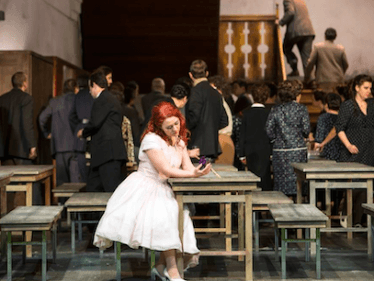La Sonnambula - Schedule, Program & Tickets
La Sonnambula
Still the operas of the romantic bel canto of a Donizetti and Bellini are decried as "Schönsangopern" without substantive depth. The beauty of the melodies, the concentration on the voice and the ability of the singers, especially at Bellini, often obscure the view of conflicts and deeper layers. In particular, LA SONNAMBULA is often received as the last flicker of a naïve pastoral play. True, the great conflicts of domination and the absolute madness are missing here, but even on a small scale tragedies take place: Amina is engaged, has already signed the marriage contract, but has not yet entered the altar with her Elvino. Coming from a humble background, she will marry the richest farmer in the village. When she wakes up at night in the bedroom of Count Rodolfo, who returns home incognito, the deceptive idyll in the Swiss Alps breaks apart: Elvino dissolves the engagement and returns to his lost lover Lisa. Only gradually does the village community realize what has really happened: the past is catching up with the protagonists.
The directing duo Jossi Wieler and Sergio Morabito have repeatedly broken a lance for Bellini's operas over the last few years: their productions by NORMA, IL PIRATA and LA SONNAMBULA reveal the deeper layers of the supposedly superficial figures through precise text analysis. At SONNAMBULA they refer to discarded material by Romani and Bellini: libretto sketches show very clearly that the paternity of Rodolfo von Amina, which was only hinted at in the final libretto, was certainly intended by the authors. This opens up new possibilities for interpretation. Amina falls out of the suspicious-dull village society with her naive sensitivity, but Lisa - the rival to the heart of Elvino - is a completely self-determined outsider. The view of the ghost, which the entire village population, but also Amina, believes to see again and again, is sharpened at Wieler / Morabito.
Bellini uses coloratura and ornaments more sparingly than his colleague Donizetti, even more economically than in his other operas. Even in Aminas' nightwalking scenes - which are to be understood as "little sisters" of the great madness scenes of the bel canto operas - the coloratura is never used as an end in itself: the composer concentrates entirely on tracing the feelings of the protagonist. Wieler and Morabito make these feelings and the psychological dimensions of the music tangible.
Subject to change.
The directing duo Jossi Wieler and Sergio Morabito have repeatedly broken a lance for Bellini's operas over the last few years: their productions by NORMA, IL PIRATA and LA SONNAMBULA reveal the deeper layers of the supposedly superficial figures through precise text analysis. At SONNAMBULA they refer to discarded material by Romani and Bellini: libretto sketches show very clearly that the paternity of Rodolfo von Amina, which was only hinted at in the final libretto, was certainly intended by the authors. This opens up new possibilities for interpretation. Amina falls out of the suspicious-dull village society with her naive sensitivity, but Lisa - the rival to the heart of Elvino - is a completely self-determined outsider. The view of the ghost, which the entire village population, but also Amina, believes to see again and again, is sharpened at Wieler / Morabito.
Bellini uses coloratura and ornaments more sparingly than his colleague Donizetti, even more economically than in his other operas. Even in Aminas' nightwalking scenes - which are to be understood as "little sisters" of the great madness scenes of the bel canto operas - the coloratura is never used as an end in itself: the composer concentrates entirely on tracing the feelings of the protagonist. Wieler and Morabito make these feelings and the psychological dimensions of the music tangible.
Subject to change.
There are no products matching the selection.


